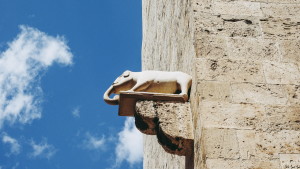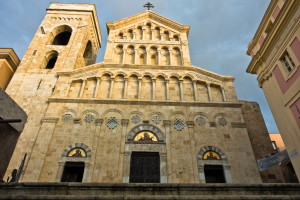
©Bigstock.com/c_73
Sardinia’s capital is situated in the south of the island. It is home to stunning beaches, glorious promenades and inviting parks. Something that doesn’t get talked about nearly enough: Cagliari is a multifaceted city of arts that showcases its extremely long, diverse history in the best way possible. Already populated in prehistoric times, it was conquered, destroyed, abandoned and re-established. Thus, you can explore the heritage of countless eras in and around Cagliari today in an architectural timelapse of sorts. To top it all off, there’s the gorgeous view of the Gulf of Cagliari from the elevated hilly city location . . . it doesn’t get much better than this!
A brief history of Cagliari
The roots of the region can be traced back to the Neolithic Age. It was very popular, particularly with the Monte Claro culture, due to its ideal position between the sea, a fertile plain, two swamp areas and, as a retreat, tall mountains. Caralis, as the region was known, later became a Phoenician colony, was placed under Roman rule after the First Punic War, served as a key naval base during the Second Punic War and eventually gained the status of municipium. Vandals invaded after the fall of the Western Roman Empire, but the incorporation into the Byzantine Empire ensured that Cagliari had a key role during the Middle Ages.
Once Byzantium started to lose influence during the 9th century five Sardinian Judicates formed, at least until Cagliari annexed Agugliastra and reduced them to four for several centuries. However, this period of independence saw the citizens leave town and found Santa Igia inland in order to escape repeated pirate attacks. The Republic of Pisa had Santa Igia destroyed during their conquests in 1258; Castel di Castro, established by merchants, became the predecessor of modern Cagliari. The region was placed under Spanish administration during the 14th century and came to the House of Savoy in 1718 giving birth to the Kingdom of Piedmont-Sardinia. Cagliari experienced a massive boom after the unification of Italy. Numerous buildings rose into the sky, accompanied by the popular Art Nouveau style and flowery ornaments.
What remains of Caralis
We stay clear of such modern times for now as the city of arts Cagliari has so much palpable history to offer. Our first point of interest is Caralis, the name of Sardinia’s capital during Punic, Roman and early Christian times. Two particularly well-preserved places illustrate its unique role for this region in a particularly exciting manner. Our first stop is Tuvixeddu, Sardinian for “hill of the little holes”. It’s called that for good reason as this originally Punic necropolis on a hill in the north of Cagliari consists of thousands of rock tombs. Another necropolis and a Roman burial place were added in later times. Aerial photos show that this area actually looks as though it has been perforated.
The most important evidence of Cagliari’s Roman heritage – aside from the so-called Heroon of the Atilia Pomptilla with poetic Greek and Roman inscriptions – is the amphitheatre. Built directly into the hill with some seats carved out of stone, it was used as a quarry for centuries sadly destroying a great deal of the massive facility that likely held 8,000 to 12,300 spectators. Starting with the first restoration and renovation in 1866 the amphitheatre was given additional wooden structures, such as corridors and tiers, turning the historic ambiance into a contemporary event location.
Cagliari Cathedral

©Bigstock.com/Banet
Cattedrale di Santa Maria Assunta e Santa Cecilia is one of many buildings where pretty much no stone was left unturned. The Pisans had a cathedral built in the then prevalent Norman-Pisan style as early as 1217. The first alterations in the 14th century changed the façade and added the transept. Similar changes occurred time and time again, although the baroque alterations that started in 1669 certainly had the greatest overall impact on the structure. You can see remains of the baroque façade – it was removed due to its ruinous state and rebuilt between the wars utilising elements of the Pisan Romanesque – in the cathedral’s museum.
These very baroque alterations are especially visible inside the cathedral as the interior was entirely adapted to this style. Among the highlights is the crypt where the remains of almost 300 Sardinian martyrs have found their final resting place. The crypt arch is decorated with 600 rosettes. The embossed silver antependium from Madrid, the finely chiselled tabernacle, the grand altarpiece with a crucifixion scene and the enthroned Madonna, and the artful multicolour marble floors will wow you. Don’t sleep on the mid-12th century marble pulpit, a Pisan gift and one of the most important Pisan works of art on the entire island.
More sights in Cagliari
Putting the ancient remains of Caralis and the ostentatious cathedral aside for a moment, there are several more highlights that make Cagliari an impressive city of arts:
- Basilica di Nostra Signora di Bonaria: The Bonaria hill in Cagliari harbours not only a necropolis, but also Sardinia’s largest pilgrimage centre. The first citadel was built around 1323/24 after Alfonso IV of Aragon had conquered all of Sardinia via Bonaria. Today’s basilica, however, is of baroque origin. Its name stems from a marvellous statue that was washed ashore in a box in 1370 according to legend. A painting by Antonio Corriga inside the basilica depicts the rescue of the statue by seamen. The associated monastery documents the history of adoration of the Virgin Mary in Bonaria in its cloister.
- Bastione di Saint Remy: The Spanish built various fortifications during the late 16th century to protect Cagliari. Two eventually became the foundation for this bastion constructed between 1896 and 1902. However, the imposing neoclassical structure carries no military role whatsoever. There’s a large observation terrace that’s very popular with locals and tourists. Here you can enjoy a magnificent view across the city of arts.
- The towers: Some parts of the old defensive facilities are still standing, such as Torre dell’Elefanto and Torre di San Pancrazio. They were originally part of the first Pisan structure in the 14th century and were used as prisons by the Spanish. Ever since the renovation in 1999 you can climb both the elephant tower – named after a small marble elephant above the gate – and the Pancrazio tower to enjoy the marvellous view.
Stone-age and baroque elements come together wonderfully and astoundingly in Cagliari. The city of arts lives and breathes many different eras finding a fascinating way of presenting all of them in their stunning variety. Gorgeous observation platforms, wonderful beaches, and numerous charming museums, cafés and restaurants set the scene for a city holiday that’s both diverse and enjoyable, even in autumn and winter. Here you get to see Sardinia at its best and most beautiful.